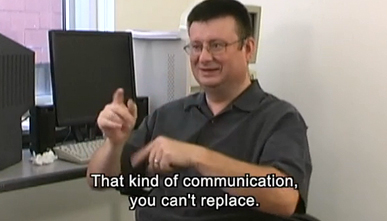Disability & Media Alliance Project
In 2008 DREDF launched the Disability & Media Alliance Project (D-MAP). The goal of the program is to change the focus from sensational, cloying and misinformed disability coverage that undermines the public policy and legal advances of the last 25 years to coverage that raises public awareness and helps to end disability discrimination.
D-MAP establishes a mechanism for monitoring and informing disability coverage in news reports, dramatic representations, and reporting on the Internet with the goal to advance accurate reporting of disability issues and promote positive images of people with disabilities.
Images and Stories

Nick Ziemer in Healthcare Stories
Media images and stories influence thinking and establish social norms. People with disabilities have endured misrepresentation, defamation, and lack of representation in the media news and entertainment. While the disability rights movement has made enormous strides in the past 30 years using law and policy development and civil rights advocacy, our movement has not yet altered the hearts and minds of people who do not have personal experience with disability. Many still do not understand disability issues as rights issues.
Fear and stereotypes about disability are deeply ingrained in our culture and reflected in media coverage, and people with disabilities are seldom seen as individuals beyond the framework of their disabilities. The legacy of demeaning, isolating, and institutionalizing people with disabilities has left in its wake negative and inaccurate beliefs and attitudes about what it means to live with a disability. These attitudes are embraced and reflected by media coverage, much of which relies on old stereotypes and misinformation.
More in-depth and thoughtful attention to disability is needed. The media is a potent force in countering stigma and misinformation and can be a powerful ally in changing perceptions, eliminating discrimination, and raising public awareness.
Video Advocacy
Video advocacy uses new image technologies to produce documentary campaigns for social and political change through visual evidence, personal stories, and precise audience targeting. Video advocacy has had a strong impact on organized advocacy and grassroots action in many areas and has become an effective new tool in the non-profit social justice community. As communications media change, digital technology, including widespread use of video storytelling, has exploded because it supports a culture of participation and sharing. Healthcare Stories takes advantage of this vital tool.
Resources
- Media & Disability Resources
- Media Representation of Disabled People
- Wikipedia article titled “Disability in the Media”
Technology accessibility
- Disability Rights and Access to the Digital World: An Advocate’s Analysis Of An Emerging Field, an article by Daniel Goldstein and Gregory Care
- Universal Design
Web accessibility
- A Dao of Web Design by John Allsopp, April 07, 2000 (Still relevant)
- Website Accessibility Initiative, a group that set standards for website accessibility
- Website Accessibility in Mind
- Website Accessibility Evaluation Tool
- Nielsen Norman Group
Legal cases
- NFB et. al. v. Target, a case about website accessibility
- NAD et. al. v. Netflix, a case on captioning movies
DREDF also has many resources available on topics ranging from writing accessible web content to principles of accessible design and beyond.
